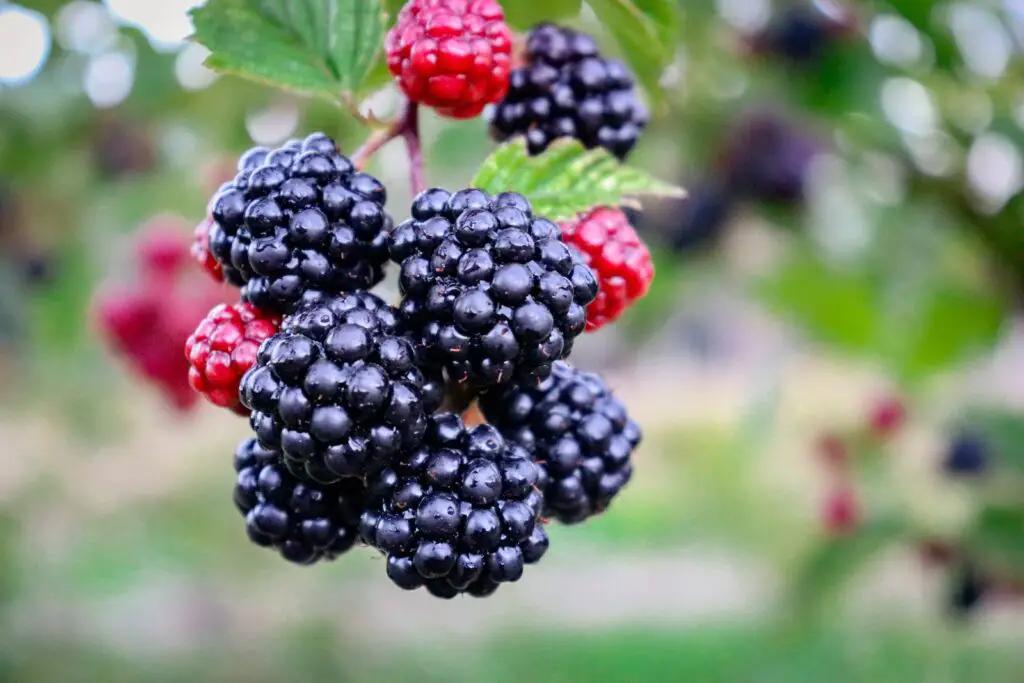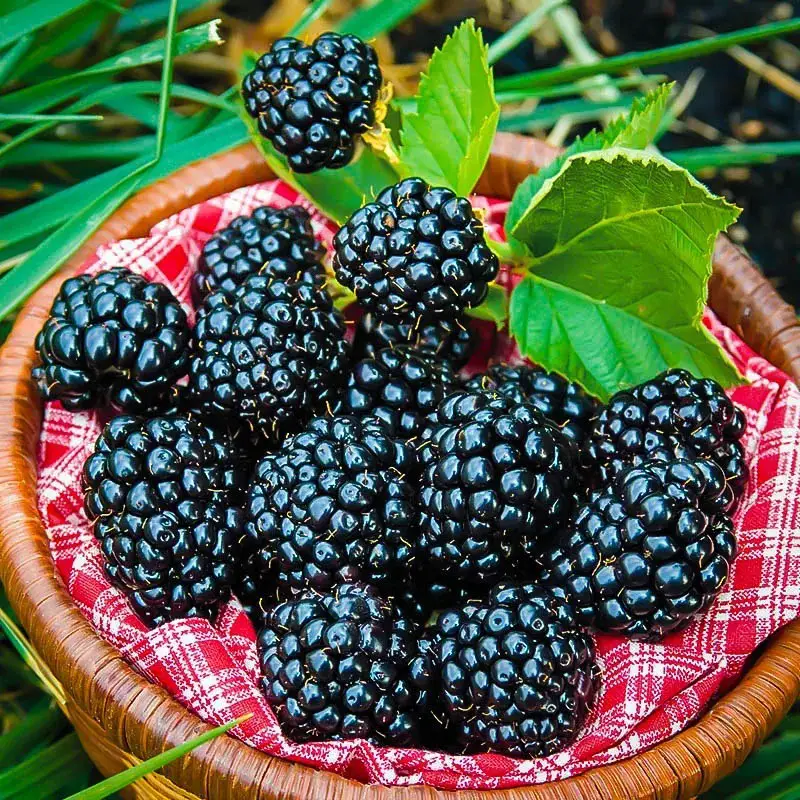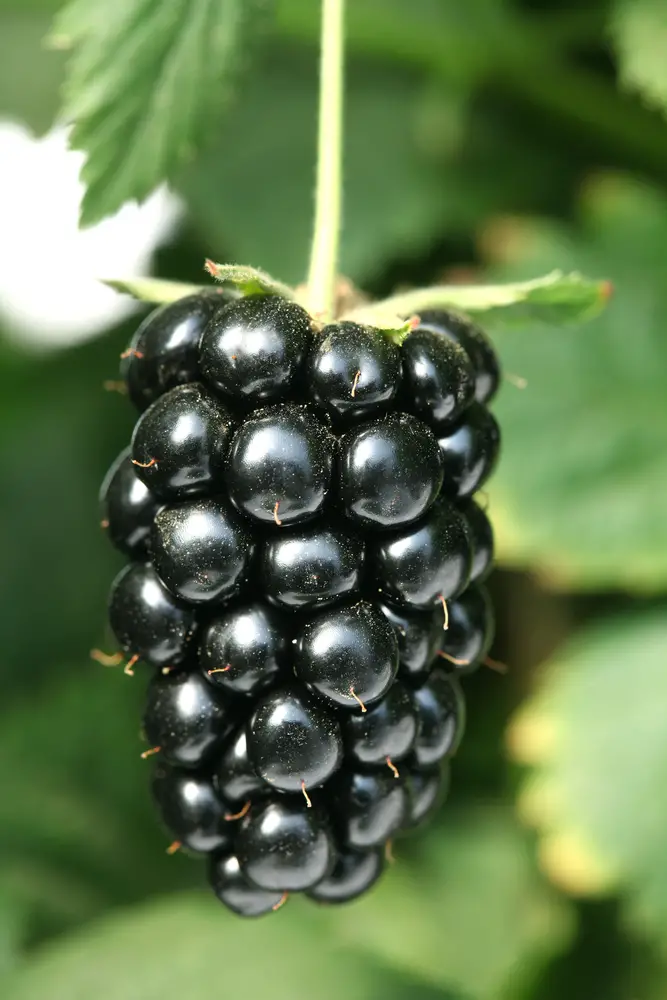
Blackberries are a popular fruit that are enjoyed by many. They are often used in desserts, jams, and other culinary applications. Despite their name, blackberries are not always completely black in color. In fact, the color of blackberries can vary depending on a number of factors.
Blackberries are a type of berry that belong to the Rosaceae family. They are typically small and round, and are characterized by their dark, juicy flesh. While blackberries are often thought of as being completely black in color, this is not always the case. The color of blackberries can vary depending on a number of factors, including the variety of the berry, the level of ripeness, and the growing conditions.
Table of Contents
What Color Are Blackberries?
Blackberries are a type of fruit that are commonly found in North America and Europe. They are typically small and round, with a dark purple or black color. The color of blackberries is actually a combination of several different hues, including red, purple, and black.
The outer skin of a blackberry is typically a deep purple or dark purple color. This color is caused by the presence of anthocyanins, which are pigments that give many fruits and vegetables their vibrant colors. Anthocyanins are also responsible for the reddish and bluish hues that can be seen in blackberries.
The flesh of a blackberry is also a dark purple color, although it can sometimes appear more reddish or blackish depending on the ripeness of the fruit. The seeds inside the blackberry are typically a light yellow or green color.
Overall, the color of blackberries can vary depending on a number of factors, including the variety of the fruit, the climate in which it was grown, and the stage of ripeness. However, most blackberries are a deep purple or black color, with hints of red and other hues.
In summary, blackberries are a dark purple or black color, with hints of red and other hues. The color of blackberries is caused by the presence of anthocyanins, which are pigments that give many fruits and vegetables their vibrant colors.
The Blackberry Fruit
Blackberries are a type of fruit that belong to the Rosaceae family. They are an aggregate fruit, which means that they are made up of many smaller fruits called drupelets. These drupelets are arranged around a central core, which gives the fruit its characteristic oval shape.
The color of blackberries is dark purple to black when they are ripe, hence the name “blackberry”. However, when they are still growing, the drupelets are red or green in color. As they ripen, the drupelets turn from red to black, and the fruit becomes sweeter and juicier.
Blackberries are rich in vitamins and minerals, and are a good source of fiber. They are also low in calories, making them a healthy snack option. In addition to being eaten fresh, blackberries can also be used in a variety of recipes, including pies, jams, and smoothies.
Overall, the blackberry fruit is a nutritious and delicious addition to any diet.
Varieties of Blackberries
Blackberries come in many varieties, each with its unique characteristics. Some of the most popular varieties of blackberries are:
Himalayan Blackberry

This variety is native to Armenia and was introduced to North America in the late 1800s. The Himalayan blackberry is known for its large, sweet berries and vigorous growth.
Thornless Blackberry

As the name suggests, this variety of blackberry is thornless, making it easier to harvest. Thornless blackberries are known for their large, juicy berries and are a popular choice for home gardeners.
Navaho

This variety of blackberry is known for its large, firm berries and excellent flavor. Navaho blackberries are also known for their disease resistance and are a popular choice for commercial growers.
Arapaho

The Arapaho blackberry is a thornless variety known for its large, sweet berries and disease resistance. This variety is also known for its early ripening, making it a popular choice for growers in cooler climates.
While blackberries are often compared to other berries like raspberries, blueberries, and strawberries, they have their unique flavor and texture. Black raspberries, for example, are similar in appearance to blackberries but have a more delicate flavor. Himalayan blackberries are often compared to raspberries, but they have a more robust flavor and larger berries.
In conclusion, blackberries come in many varieties, each with its unique characteristics. Whether you prefer a thornless variety or a variety with large, sweet berries, there is a blackberry for everyone.
Blackberries and Their Nutritional Value
Blackberries are a delicious and nutritious fruit that are packed with essential vitamins, minerals, and antioxidants. In fact, blackberries are considered one of the healthiest fruits due to their high nutritional value and low calorie count.
One cup of blackberries (approximately 144 grams) contains the following nutrients:
- Calories: 62
- Carbohydrates: 14.7 grams
- Fiber: 7.6 grams (3.1 grams of insoluble fiber and 4.5 grams of soluble fiber)
- Protein: 2 grams
- Fat: 0.7 grams
Blackberries are also an excellent source of vitamins and minerals, including:
- Vitamin C: 50% of the recommended daily intake (RDI)
- Vitamin K: 36% of the RDI
- Manganese: 47% of the RDI
- Calcium: 5% of the RDI
- Potassium: 5% of the RDI
- Iron: 4% of the RDI
In addition to these essential vitamins and minerals, blackberries are also rich in antioxidants, particularly anthocyanins. These powerful antioxidants are responsible for the dark purple color of blackberries and have been linked to a range of health benefits, including reduced inflammation and a lower risk of chronic diseases like heart disease and cancer.
Overall, blackberries are an excellent addition to a healthy and balanced diet. They are low in calories and high in fiber, making them a great choice for weight management and digestive health. Plus, their high antioxidant content makes them a great choice for overall health and wellness.
Health Benefits of Blackberries
Blackberries are not only delicious but also packed with essential nutrients and antioxidants that offer various health benefits. Here are some of the health benefits associated with consuming blackberries:
Anti-Inflammatory Properties
Blackberries contain compounds such as anthocyanins and flavonols that have anti-inflammatory properties. These compounds help to reduce inflammation in the body, which is associated with chronic diseases such as cancer, heart disease, and diabetes.
Cancer Prevention
Blackberries are rich in antioxidants such as vitamin C, vitamin E, and ellagic acid, which help to protect the body against oxidative stress. Oxidative stress can damage cells and DNA, leading to the development of cancer. The high levels of antioxidants in blackberries may help to prevent the growth and spread of cancer cells.
Heart Health
The fiber, potassium, and vitamin C in blackberries help to support heart health. Fiber helps to lower cholesterol levels, while potassium helps to regulate blood pressure. Vitamin C is also essential for maintaining the health of blood vessels.
Diabetes Management
Blackberries have a low glycemic index, which means they do not cause a rapid increase in blood sugar levels. This makes them an excellent choice for people with diabetes. Additionally, the polyphenols in blackberries may improve insulin sensitivity, which is important for managing diabetes.
In conclusion, blackberries are a nutritious and delicious fruit that offer various health benefits. Incorporating them into one’s diet may help to prevent chronic diseases such as cancer and heart disease, as well as manage conditions such as diabetes.
Culinary Uses of Blackberries
Blackberries are a versatile fruit that can be used in a variety of culinary applications. They can be enjoyed fresh, frozen, or cooked in a variety of dishes. In this section, we will explore some of the most popular culinary uses of blackberries.
Fresh Blackberries
Fresh blackberries are a delicious and healthy snack that can be enjoyed on their own or added to salads, smoothies, and other dishes. They are also a popular ingredient in fruit tarts and pies.
Frozen Blackberries
Frozen blackberries are a convenient way to enjoy the flavor and nutritional benefits of blackberries year-round. They can be used in smoothies, baked goods, and other dishes, and are a great addition to homemade ice cream.
Blackberry Jam and Preserves
Blackberry jam and preserves are a classic way to enjoy the flavor of blackberries. They can be spread on toast, used as a topping for ice cream, or added to baked goods. Blackberry jam is also a popular ingredient in thumbprint cookies and other desserts.
Blackberry Pie and Cobbler
Blackberry pie and cobbler are classic desserts that are perfect for showcasing the sweet and tangy flavor of blackberries. They can be made with fresh or frozen blackberries, and are often served with a scoop of vanilla ice cream.
Blackberry Salad
Blackberries can be used to add a sweet and tangy flavor to salads. They pair well with spinach, arugula, and other greens, and can be combined with nuts, cheese, and other ingredients to create a delicious and healthy salad.
Blackberry Smoothie
Blackberry smoothies are a refreshing and healthy way to start the day. They can be made with fresh or frozen blackberries, and can be combined with yogurt, milk, and other ingredients to create a delicious and nutritious breakfast or snack.
Overall, blackberries are a versatile fruit that can be used in a variety of culinary applications. Whether you prefer them fresh, frozen, or cooked, blackberries are a delicious and healthy addition to any meal or snack.
The Basics for Growing Erect Variety Blackberries
Cultivation and Harvesting of Blackberries
Blackberries are a popular fruit that can be grown in a variety of climates and soil types. They are a member of the Rosaceae family and are native to North America and Europe. Blackberries can be grown in both wild and cultivated settings with different methods of planting and harvesting depending on the type of blackberry.
When planting blackberries, it is important to choose a location that receives full sun and has well-drained soil. Blackberries can be planted in the spring or fall, and should be spaced about 3-4 feet apart. They can be planted in rows or in a trellis system to support the canes.
Blackberries can be fertilized with nitrogen in the spring and again in mid-summer to encourage growth. Pruning is an important part of blackberry cultivation, with floricanes and primocanes requiring different methods of pruning. Floricanes are the canes that produce fruit and should be pruned after harvest. Primocanes are the new growth that will produce fruit the following year and should be pruned in the winter.
Harvesting blackberries can be done by hand-picking or using a mechanical harvester. The fruit should be picked when it is fully ripe, which can be determined by its color and texture. Blackberries can be stored for a short period of time in the refrigerator or frozen for later use.
Thornless blackberry varieties have become increasingly popular for their ease of harvesting, but wild blackberries can still be found in many areas. Blackberries have a relatively short growing season, typically from June to August in North America.
Post-Harvesting Processes
After harvesting blackberries, post-harvesting processes are important to ensure that the fruit stays fresh and retains its quality. There are several methods that can be used to preserve blackberries, including freezing, canning, and drying.
Freezing
Freezing is a popular method of preserving blackberries. It involves washing the fruit thoroughly and removing any damaged or bruised berries. The berries can then be placed in a single layer on a baking sheet and frozen for several hours. Once frozen, the berries can be transferred to a freezer bag or container for long-term storage.
Canning
Canning is another method of preserving blackberries. It involves washing the fruit and placing it in jars with syrup or water. The jars are then heated in a water bath or pressure canner to kill any bacteria and seal the jars. Canned blackberries can be stored for several months.
Drying
Drying is a method of preserving blackberries that involves removing the moisture from the fruit. This can be done by placing the berries in a dehydrator or oven at a low temperature until they are dry and leathery. Dried blackberries can be stored in an airtight container for several months.
Overall, post-harvesting processes are important to ensure that blackberries stay fresh and retain their quality. Freezing, canning, and drying are all effective methods of preserving blackberries, and each method has its own advantages and disadvantages.
Blackberries in Different Regions
Blackberries are a type of fruit that grow in various regions around the world. In North America, blackberries are commonly found in the Pacific Northwest region, which includes parts of Oregon, Washington, and British Columbia. The most common species of blackberry found in this region is the Rubus ursinus, also known as the Pacific blackberry.
The Pacific blackberry is known for its large, juicy berries and is typically harvested in late summer. These blackberries are often used in jams, jellies, and baked goods. In addition to the Pacific Northwest, blackberries also grow in other temperate regions around the world.
In Europe, for example, blackberries are commonly found in the United Kingdom, where they are known as brambles. In Australia, blackberries are considered an invasive species and are found in many different regions. In South America, blackberries are grown in countries such as Chile and Argentina.
Despite the different regions in which blackberries are grown, they all share similar characteristics. Blackberries are typically small, dark berries that are rich in antioxidants and other nutrients. They are also known for their sweet and slightly tart flavor, which makes them a popular ingredient in many different types of dishes.
Overall, blackberries are a versatile fruit that can be enjoyed in many different regions around the world. Whether you’re picking them fresh from the vine or using them in your favorite recipes, blackberries are a delicious and nutritious addition to any meal.
Blackberries and Their Environmental Impact
Blackberries are a natural part of the environment and are commonly found in the wild. They are biennial plants that grow from suckers, which are shoots that grow from the roots of the parent plant. Blackberries are known to have a positive environmental impact, as they provide food and habitat for many animals, including birds, insects, and small mammals.
However, blackberries can also have a negative impact on the environment. They are known to be invasive in some areas, where they can outcompete native plant species and disrupt the natural ecosystem. Blackberries are also susceptible to fungal diseases, such as rust and cane blight, which can spread to other plants and cause further damage.
Thimbleberries, which are closely related to blackberries, are also found in the wild and can have similar environmental impacts. They are known for their delicate, thimble-shaped fruits and are a popular food source for many animals.
Overall, blackberries and thimbleberries can have both positive and negative environmental impacts, depending on the specific ecosystem in which they are found. It is important to manage these plants carefully and monitor their spread to ensure that they do not cause harm to native species or disrupt the natural balance of the environment.